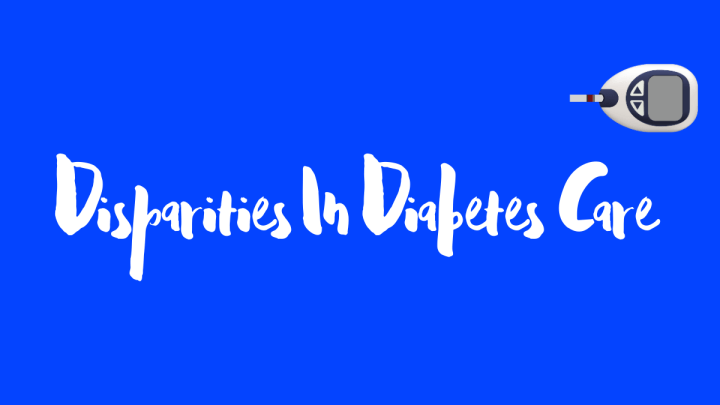
Updated Thursday Sept. 10, 2020
The anti-racism work that’s gained momentum around the country and around the world over the past two weeks does not just start and end with police and criminal justice reform. I work in diabetes research, so I’m going to share one example of how systemic racism impacts diabetes treatment and access to care.
Technology
Technology for type 1 diabetes has advanced rapidly over the past few decades. We now have the ability to monitor blood sugar in real time with continuous glucose monitors (CGMs), and two hybrid closed loop systems (HCL) which automatically adjust insulin based on CGM readings are now commercially available. These systems have dramatically shifted diabetes care, and allowed for tightening of glycemic control and improved quality of life for some. Unfortunately, use of CGM is still low (30% from 2016-2018), and racial disparities are evident when looking at access to these technologies.
Just last month, an abstract detailing racial/ethnic differences in use of CGM and CSII (AKA insulin pumps) was published in the Journal of the Endocrine Society. Authors (Wirunsawanya et. al.) found that patients with government health insurance had significantly lower odds of using technology compared with patients who had private health insurance. In the same study, authors found that use of technology in the Caucasian group was significantly higher even after adjusting for type of insurance than in non-Caucasian groups (with the exception of Asian patients in this study).
Furthermore, authors found association between use of technology and lower HbA1c. I’ve mentioned in previous posts some of the problems of using A1c as a sole measure of glycemic control, and the possible bias associated with HbA1c, but there is substantial evidence to suggest that access to technology (especially CGMs) can improve glycemic control.
This is not the first time data has been published on racial disparities in diabetes management and use of technology. Multiple studies have shown greater use of insulin pump therapy in white participants even after adjusting for gender, diabetes duration, and socioeconomic status.
While there are a number of factors that may affect use of technology for diabetes, interaction between POC with diabetes and primarily white healthcare providers along with subliminal racial bias in the diabetes care likely plays a role. Bias, stereotyping, prejudice, and clinical uncertainty contribute to disparities in care.
Because most of us hopefully went into healthcare with the intent NOT to cause harm, here are some recommendations for healthcare professionals (some are adapted from the IOM):
1. Listen to your patients!
This is something you can start working on immediately. Take the time to really listen to your patients, and ask questions. Rather than making immediate assumptions, ask your patients what they need and what they want. It’s easy to fall into the pattern of making assumptions on patients’ needs based on their medical chart, what you learned in school, or what you’ve experienced; but each patient is a different individual with different needs and wants, so take the time to ask and to listen.
2. Increase awareness of biases and disparities in healthcare
Here is a list of resources on Health disparities and inequalities:
- National Healthcare Quality and Disparities Reports
- CDC Health Disparities & Inequalities Reports
- National Cancer Institute Health Disparities Surveillance Program
- CDC Diabetes Report Card
- Exploring Unconscious Bias in Academic Medicine (Vimeo Video)
- What happens when patients become leaders on the health team (Youtube video)
- W.K. Kellogg Foundation Racial Equity Resource Guide
- National Institute on Minority Health and Health Disparities
3. “Promote the consistency and equity of care through the use of evidence-based guidelines.”
This also means doing your best to offer the same care options to all patients, regardless of race/ethnicity, socioeconomic status, or insurance coverage. While it is not always easy, fighting for coverage for essential supplies for all patients is part of the job these days. In order to deliver the best care possible, we need to be there for our patients.
4. Increase the proportion of underrepresented minorities among health professionals.
Did you know that 81.1% of RDs and RDNs are white? Diversify Dietetics is a great organization working to increase diversity in the nutrition profession, and there are a number of other organizations working to diversify the various healthcare professions.
Listen and learn from both your patients and colleagues, and when possible, consider referring patients to colleagues that patients may better identify with. Mentorship is challenging to find in the field of dietetics, so if in a position to do so, consider mentoring students or interns.
National Science Foundation also publishes information about participation of women, minorities and persons with disabilities in Science and Engineering.
Note: I have been and will continue to answer any questions and mentor students on the path to becoming an RD as I know from personal experience that it can be challenging to navigate. Please email me if you have any questions.
5. Finally, we can fight for this technology to become standard of care, and fight for access for all patients!
This means proving this technology improves care through research, but it also means advocating to local legislators for increased access to care, caps on drug prices, and better insurance coverage for devices.
